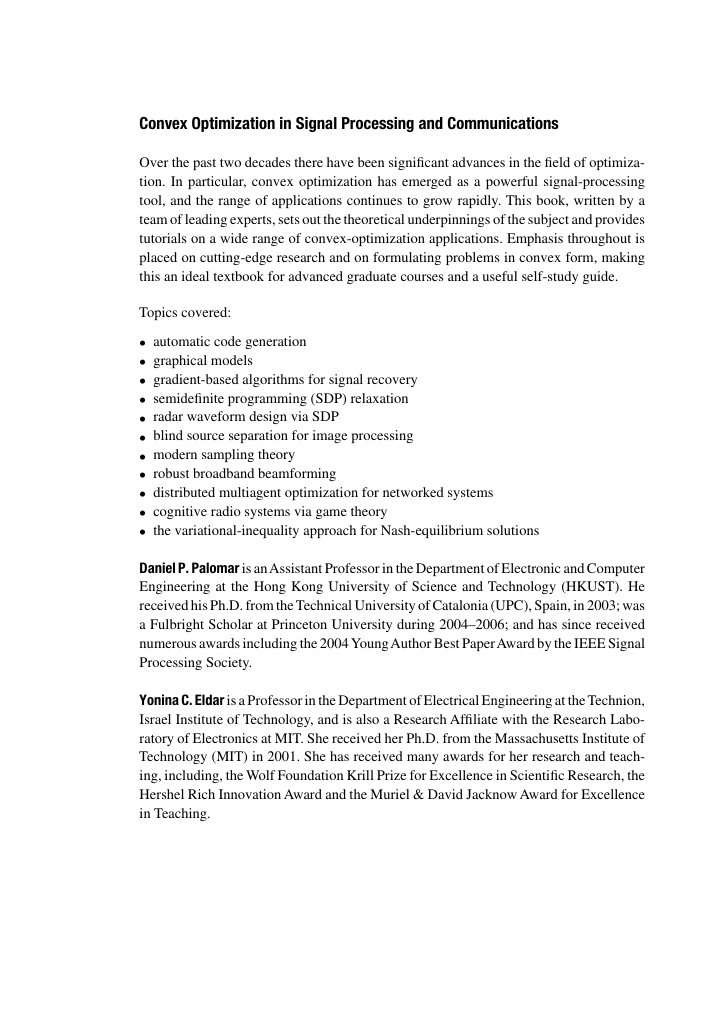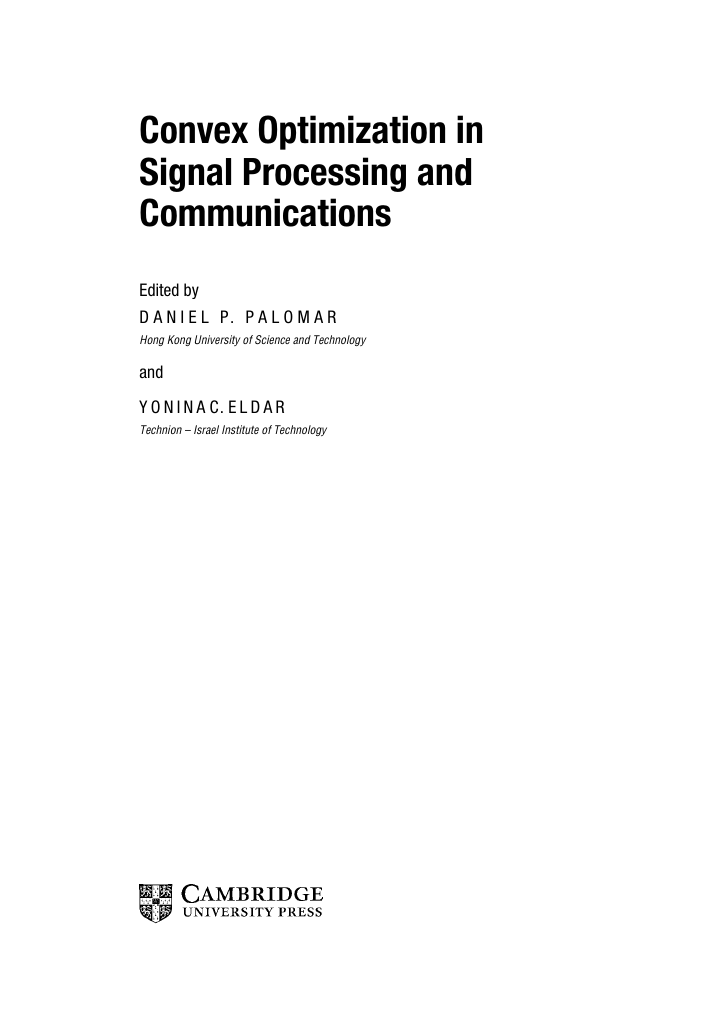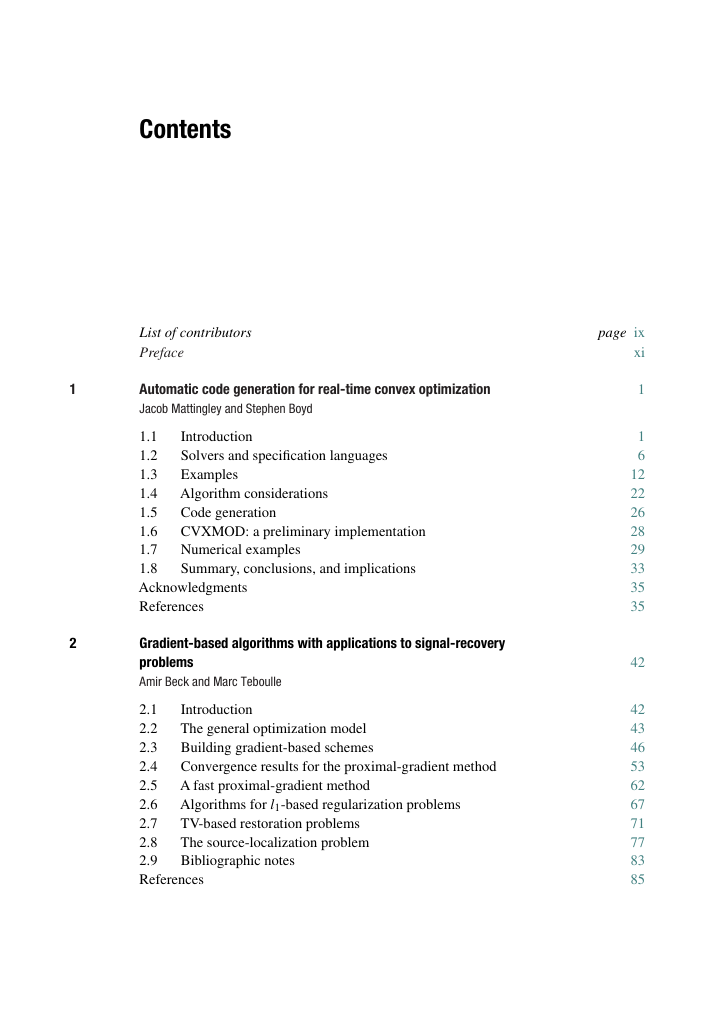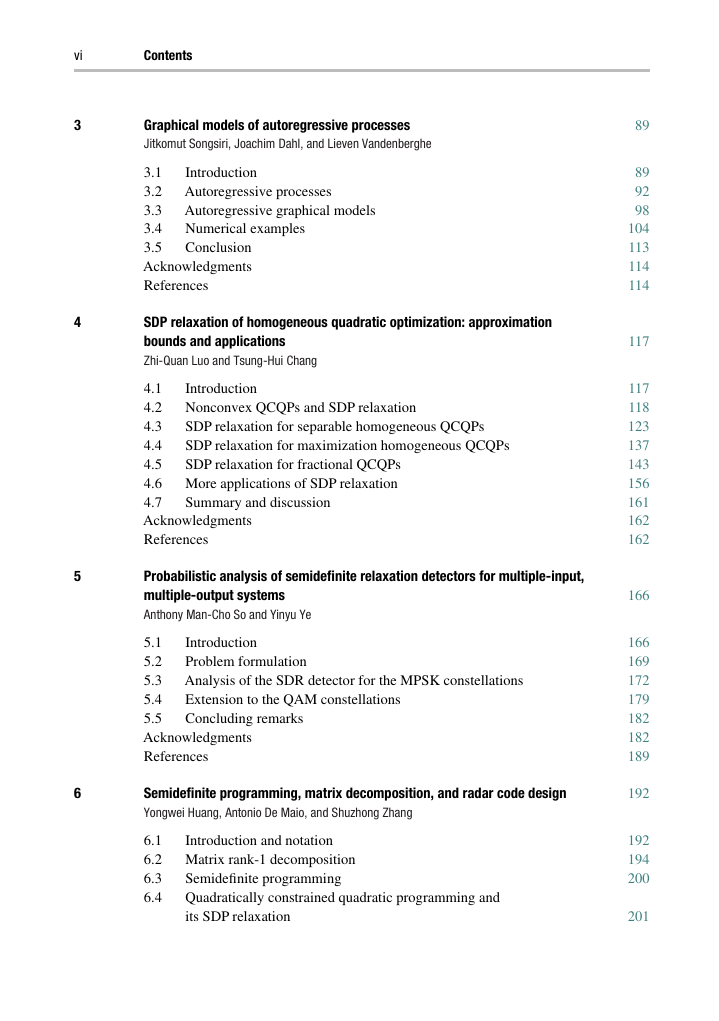Half-title
Title
Copyright
Contents
List of contributors
Preface
1 Automatic code generation for real-time convex optimization
1.1 Introduction
1.1.1 Advisory optimization
1.1.2 Embedded optimization
1.1.3 Convex optimization
1.1.4 Outline
1.1.5 Previous and related work
Control
Signal processing, communications, and networking
Code generation
1.2 Solvers and specification languages
1.2.1 Problem families and instances
1.2.2 Solvers
1.2.3 Specification languages
1.2.4 Parser-solvers
1.2.5 Code generators
1.2.6 Example from CVXMOD
1.3 Examples
Real-time adaptation
Real-time trajectory planning
Feedback control
Real-time sensing, estimation, or detection
Real-time system identification
1.3.1 Adaptive filtering and equalization
1.3.2 Optimal order execution
1.3.3 Sliding-window smoothing
1.3.4 Sliding-window estimation
1.3.5 Real-time input design
1.3.6 Model predictive control
1.3.7 Optimal network flow rates
1.3.8 Optimal power generation and distribution
1.3.9 Processor-speed scheduling
1.4 Algorithm considerations
1.4.1 Requirements
Stability and reliability
Graceful handling of infeasibility
Guaranteed-run time bounds
1.4.2 Exploitable features
Known (and often modest) accuracy requirements
Good initializations are often available
Variable ranges can be determined
1.4.3 Interior-point methods
1.4.4 Solving systems with KKT-like structure
1.5 Code generation
1.5.1 Custom KKT solver
1.5.2 Additional optimizations
1.6 CVXMOD: a preliminary implementation
1.6.1 Algorithm
1.7 Numerical examples
1.7.1 Model predictive control
1.7.2 Optimal order execution
1.7.3 Optimal network flow rates
1.7.4 Real-time actuator optimization
1.8 Summary, conclusions, and implications
Acknowledgments
References
2 Gradient-based algorithms with applications to signal-recovery problems
2.1 Introduction
2.2 The general optimization model
2.2.1 Generic problem formulation
2.2.2 Signal recovery via nonsmooth regularization
2.3 Building gradient-based schemes
2.3.1 The quadratic-approximation model for (M)
2.3.2 The fixed-point approach
2.3.3 Majorization–minimization technique
The idea
The MM method for the RLS problem
2.3.4 Fermat–Weber location problem
2.4 Convergence results for the proximal-gradient method
2.4.1 The prox-grad map
2.4.2 Fundamental inequalities
2.4.3 Convergence of the proximal-gradient method: the convex case
Proximal-gradient method with constant stepsize
Proximal-gradient method with backtracking
2.4.4 The nonconvex case
2.5 A fast proximal-gradient method
2.5.1 Idea of the method
2.5.2 A fast proximal-gradient method using two past iterations
Fast proximal gradient method with constant stepsize
Fast proximal-gradient method with backtracking
2.5.3 Monotone versus nonmonotone
Monotone fast proximal-gradient method
2.6 Algorithms for l1-based regularization problems
2.6.1 Problem formulation
2.6.2 ISTA: iterative shrinkage/thresholding algorithm
2.6.3 FISTA: fast ISTA
2.6.4 Numerical examples
2.7 TV-based restoration problems
2.7.1 Problem formulation
2.7.2 TV-based denoising
2.7.3 TV-based deblurring
2.7.4 Numerical example
2.8 The source-localization problem
2.8.1 Problem formulation
2.8.2 The simple fixed-point algorithm: definition and analysis
2.8.3 The SWLS algorithm
2.9 Bibliographic notes
References
3 Graphical models of autoregressive processes
3.1 Introduction
Notation
3.2 Autoregressive processes
3.2.1 Least-squares linear prediction
3.2.2 Maximum-likelihood estimation
3.2.3 Maximum-entropy estimation
3.3 Autoregressive graphical models
3.3.1 Conditional independence in time series
3.3.2 Maximum-likelihood and maximum-entropy estimation
3.3.3 Properties of block-Toeplitz sample covariances
Exactness of the relaxation
Stability of estimated models
3.3.4 Summary
3.4 Numerical examples
3.4.1 Randomly generated data
3.4.2 Model selection
3.4.3 Air pollution data
3.4.4 stock marketsInternational
3.4.5 European stock markets
3.5 Conclusion
Acknowledgments
References
4 SDP relaxation of homogeneous quadratic optimization: approximation bounds and applications
4.1 Introduction
4.2 Nonconvex QCQPs and SDP relaxation
4.2.1 SDP relaxation
4.2.2 Extracting a rank-1 solution: Gaussian sampling
4.2.3 Approximation ratio
4.3 SDP relaxation for separable homogeneous QCQPs
4.3.1 Separable homogeneous QCQPs
4.3.2 Downlink transmit beamforming
4.3.3 SDP relaxation for unicast transmit beamforming
4.3.4 SDP relaxation for far-field, multicast transmit beamforming
4.3.5 SDP relaxation for single-group, multicast transmit beamforming
Worst-case approximation bounds
Numerical results
4.4 SDP relaxation for maximization homogeneous QCQPs
4.4.1 Worst-case approximation bounds
4.4.2 Numerical results
4.5 SDP relaxation for fractional QCQPs
4.5.1 SDP relaxation for fractional QCQPs
Worst-case approximation bounds
4.5.2 SDP relaxation for generalized fractional QCQPs
Worst-case approximation bounds
Numerical results
4.6 More applications of SDP relaxation
4.6.1 SDP relaxation for the magnitude least-squares (MLS) problem
4.6.2 SDP relaxation for the magnitude-squared least-squares (MSLS) problem
4.7 Summary and discussion
Acknowledgments
References
5 Probabilistic analysis of semidefinite relaxation detectors for multiple-input, multiple-output systems
5.1 Introduction
5.2 Problem formulation
5.3 Analysis of the SDR detector for the MPSK constellations
5.3.1 The…
5.3.2 The M = 2 case
5.4 Extension to the QAM constellations
5.5 Concluding remarks
Acknowledgments
A5 Appendix to Chapter 5. Some probabilistic estimates
A5.1 Bounding the largest singular value of an arbitrary matrix
A5.2 The largest singular value of a complex Gaussian random matrix
A5.3 The largest singular value of a real Gaussian random matrix
A5.4 The squared-norm of a complex Gaussian random vector
References
6 Semidefinite programming, matrix decomposition, and radar code design
6.1 Introduction and notation
6.2 Matrix rank-1 decomposition
6.2.1 Rank-1 matrix decomposition schemes
6.2.2 Numerical performance
6.3 Semidefinite programming
6.4 Quadratically constrained quadratic programming and its SDP relaxation
6.5 Polynomially solvable QCQP problems
6.5.1 QCQP problem with two constraints
6.5.2 QCQP problem with three constraints
6.5.3 QCQP problem with homogeneous functions
6.6 The radar code-design problem
6.6.1 Background
6.6.2 System model
6.7 Performance measures for code design
6.7.1 Detection probability
6.7.2 Doppler frequency estimation accuracy
6.7.3 The similarity constraint
6.8 Optimal code design
6.9 Performance analysis
6.10 Conclusions
A6 Appendix to Chapter 6
A6.1 Proof of Proposition 6.1
A6.2 Feasibility of (QP), (EQPR), and (EQPRD)
A6.2.1 Feasibility of (QP)
A6.2.2 Feasibility of (EQPR)
A6.2.3 Feasibility of (EQPRD)
References
7 Convex analysis for non-negative blind source separation with application in imaging
7.1 Introduction
7.2 Problem statement
7.2.1 Assumptions
7.3 Review of some concepts in convex analysis
7.3.1 Affine hull
7.3.2 Convex hull
7.4 Non-negative blind source-separation criterion via CAMNS
7.4.1 Convex analysis of the problem, and the CAMNS criterion
7.4.2 An alternative form of the CAMNS criterion
7.5 Systematic linear-programming method for CAMNS
7.6 Alternating volume-maximization heuristics for CAMNS
7.7 Numerical results
7.7.1 Example of 3-source case: cell separation
7.7.2 Example of 4-source case: ghosting effect
7.7.3 Example of 5-source case: human face separation
7.7.4 Monte Carlo simulation: noisy environment
7.8 Summary and discussion
A7 Appendix to Chapter 7
A7.1 Proof of Lemma 7.2
A7.2 Proof of Proposition 7.1
A7.3 Proof of Lemma 7.5
A7.4 Proofof Lemma 7.6
A7.5 Proof of Lemma 7.7
A7.6 Proof of Theorem 7.3
Acknowledgments
References
8 Optimization techniques in modern sampling theory
8.1 Introduction
8.2 Notation and mathematical preliminaries
8.2.1 Notation
8.2.2 Projections
8.2.3 Frames
8.3 Sampling and reconstruction setup
8.3.1 Signal priors
Subspace priors
Smoothness priors
8.3.2 Sampling process
8.3.3 Reconstruction method
Unconstrained reconstruction
Constrained reconstruction
8.4 Optimization methods
8.5 Subspace priors
8.5.1 Unconstrained reconstruction
Least-squares recovery
Minimax recovery
8.5.2 Constrained reconstruction
Least-squares recovery
Minimax recovery
8.6 Smoothness priors
8.6.1 Unconstrained reconstruction
Least-squares approximation
Minimax recovery
8.6.2 Constrained reconstruction
Least-squares approximation
Minimax-regret recovery
8.7 Comparison of the various scenarios
8.8 Sampling with noise
8.8.1 Quadratic-optimization problems
8.8.2 Minimax recovery using SDP relaxation
8.9 Conclusions
Acknowledgments
References
9 Robust broadband adaptive beamforming using convex optimization
9.1 Introduction
9.2 Background
9.2.1 Linearly constrained minimum variance beamformer
9.2.2 Diagonal loading
9.3 Robust broadband beamformers
9.3.1 Robust beamformer with separate magnitude and phase constraints
9.3.2 Robust beamformer with combined magnitude and phase constraints
9.3.3 Robust beamformer with Chebychev constraints
9.3.4 Robust beamformer without frequency discretization
9.3.5 Summary of the proposed techniques
9.4 Simulations
9.5 Conclusions
Acknowledgments
References
10 Cooperative distributed multi-agent optimization
10.1 Introduction and motivation
10.2 Distributed-optimization methods using dual decomposition
10.2.1 Basic notation and terminology
10.2.2 Primal and dual problem
Duality gap and dual solutions
Dual-subgradient method
10.2.3 Distributed methods for utility-based network-resource allocation
10.2.4 Approximate primal solutions and rate analysis
Boundedness of dual iterates
Convergence-rate estimates
10.2.5 Numerical example
10.3 Distributed-optimization methods using consensus algorithms
10.3.1 Problem and algorithm
Problem
Algorithm
Representation using transition matrices
10.3.2 Information-exchange model
10.3.3 Convergence of transition matrices
10.3.4 Convergence analysis of the subgradient method
Disagreement estimate
Estimate for the auxiliary sequence
Performance bound for the algorithm
10.4 Extensions
10.4.1 Quantization effects on optimization
Performance bound for the quantized method
10.4.2 Consensus with local constraints
Convergence and rate of convergence results
10.5 Future work
10.5.1 Optimization with delays
10.5.2 Optimization with constraints
10.5.3 Nonconvex local-objective functions
10.6 Conclusions
10.7 Problems
References
11 Competitive optimization of cognitive radio MIMO systems via game theory
11.1 Introduction and motivation
11.1.1 Interference constraints: individual and conservative versus global and flexible
11.1.2 System design: a game-theoretical approach
11.1.3 Outline
11.1.4 Notation
11.2 Strategic non-cooperative games: basic solution concepts and algorithms
11.2.1 Existence and uniqueness of the NE
Existence of a Nash solution
Uniqueness of a Nash solution
11.2.2 Convergence to a fixed point
11.3 Opportunistic communications over unlicensed bands
11.3.1 Properties of the multiuser waterfilling mapping
11.3.2 MIMO waterfilling as a projector
11.3.3 Contraction properties of the multiuser MIMO waterfilling mapping
Intermediate definitions
Case of full row-rank (fat/square) channel matrices
Case of full column-rank (tall) channel matrices
Case of full-rank channel matrices
11.3.4 Existence and uniqueness of the Nash equilibrium
11.3.5 Distributed algorithms
11.4 Opportunistic communications under individual interference constraints
11.4.1 Game with null constraints
Nash equilibria: existence and uniqueness
Distributed algorithms
11.4.2 Game with null constraints via virtual noise shaping
Nash equilibria: existence and uniqueness
Distributed algorithms
11.4.3 Game with null and soft constraints
Nash equilibria: existence and uniqueness
Distributed algorithms
11.5 Opportunistic communications under global interference constraints
11.5.1 Equilibrium solutions: existence and uniqueness
11.5.2 Distributed algorithms
11.6 Conclusions
Acknowledgments
References
12 Nash equilibria: the variational approach
12.1 Introduction
12.2 The Nash-equilibrium problem
12.2.1 Review of multifunctions
12.2.2 Connection to variational inequalities
12.2.3 The Karush–Kuhn–Tucker conditions
12.2.4 Regularization and single-valued formulations
12.3 Existence theory
12.3.1 Special cases
12.3.2 A game with prices
12.3.3 Jointly convex constraints
12.3.4 The NCP approach
12.4 Uniqueness theory
12.4.1 A matrix-theoretic criterion
12.5 Sensitivity analysis
12.5.1 Local uniqueness
12.5.2 Stability of an equilibrium
12.6 Iterative algorithms
12.6.1 Non-expansiveness of the proximal responses
12.6.2 Descent methods for variational equilibria
12.7 A communication game
12.7.1 A model with QoS constraints
12.7.2 Exogenous prices
12.7.3 Endogenous prices
Acknowledgments
References
Afterword
Index
















 2023年江西萍乡中考道德与法治真题及答案.doc
2023年江西萍乡中考道德与法治真题及答案.doc 2012年重庆南川中考生物真题及答案.doc
2012年重庆南川中考生物真题及答案.doc 2013年江西师范大学地理学综合及文艺理论基础考研真题.doc
2013年江西师范大学地理学综合及文艺理论基础考研真题.doc 2020年四川甘孜小升初语文真题及答案I卷.doc
2020年四川甘孜小升初语文真题及答案I卷.doc 2020年注册岩土工程师专业基础考试真题及答案.doc
2020年注册岩土工程师专业基础考试真题及答案.doc 2023-2024学年福建省厦门市九年级上学期数学月考试题及答案.doc
2023-2024学年福建省厦门市九年级上学期数学月考试题及答案.doc 2021-2022学年辽宁省沈阳市大东区九年级上学期语文期末试题及答案.doc
2021-2022学年辽宁省沈阳市大东区九年级上学期语文期末试题及答案.doc 2022-2023学年北京东城区初三第一学期物理期末试卷及答案.doc
2022-2023学年北京东城区初三第一学期物理期末试卷及答案.doc 2018上半年江西教师资格初中地理学科知识与教学能力真题及答案.doc
2018上半年江西教师资格初中地理学科知识与教学能力真题及答案.doc 2012年河北国家公务员申论考试真题及答案-省级.doc
2012年河北国家公务员申论考试真题及答案-省级.doc 2020-2021学年江苏省扬州市江都区邵樊片九年级上学期数学第一次质量检测试题及答案.doc
2020-2021学年江苏省扬州市江都区邵樊片九年级上学期数学第一次质量检测试题及答案.doc 2022下半年黑龙江教师资格证中学综合素质真题及答案.doc
2022下半年黑龙江教师资格证中学综合素质真题及答案.doc